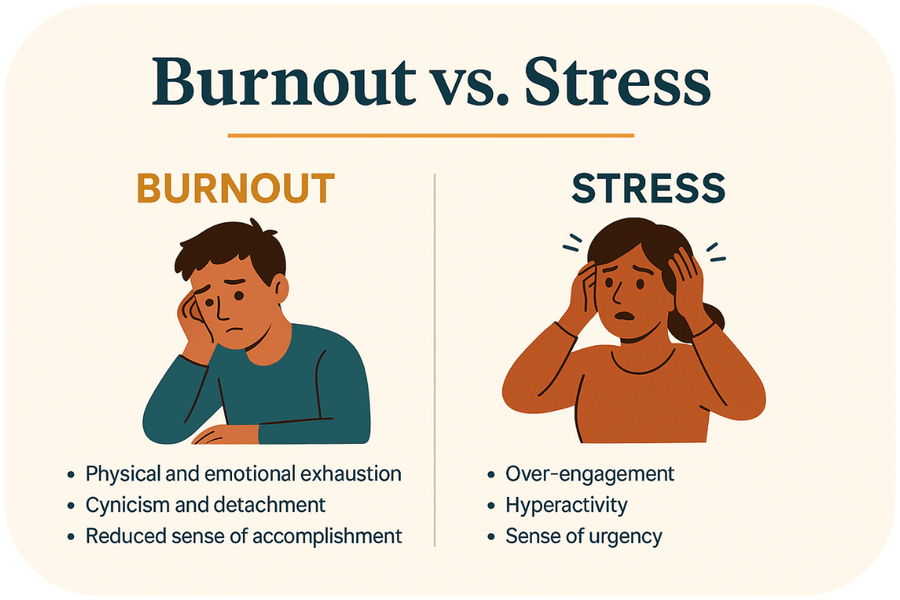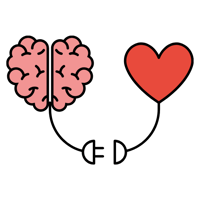.png?width=480&height=600&name=Blue%20and%20Yellow%20Modern%20Improve%20Your%20Business%20Image%20with%20a%20Professional%20Website%20Instagram%20Post%20(4).png)
Burnout isn’t just in your head—it’s in the data
You’re not alone—burnout is more common than you might think, with nearly 77% of professionals feeling its impact. Experiencing burnout isn’t a personal failing; it’s your mind and body’s response to prolonged stress without enough time to recover.
In this guide, you’ll find a clear understanding of burnout, the factors that contribute to it, practical ways to prevent it, and a relatable story that highlights how therapy and setting boundaries can help you reclaim your balance and move forward with confidence.
You'll Learn:
- Understanding what burnout truly means
- How to recognize early signs in yourself and others
- Why driven, passionate people are especially vulnerable
- The personal and professional toll of ignoring burnout
- Supportive steps for recovery and lasting well-being

Burnout Doesn’t Have to Define You
Discover real strategies and insights to overcome burnout and reclaim your energy.
Section 1 – What is Burnout?
Burnout goes far beyond everyday stress. It’s a deep sense of emotional, physical, and mental exhaustion that builds up over time—often from ongoing demands at work, caregiving, academics, parenting, or any role that asks a lot of you. Compassion and understanding are key to recognizing burnout and finding your way forward.
Clinical Definition:
A syndrome resulting from chronic workplace stress that has not been successfully managed, characterized by:
-
- Emotional exhaustion – Feeling drained, unable to cope, lacking energy.
- Cynicism or detachment – Mentally distancing yourself from work, colleagues, or responsibilities.
- Reduced professional efficacy – Decreased performance, confidence, and productivity.
Plain-English Definition:
Your “on” switch is jammed. You can’t rest, no matter how much you try. You wake up tired, small tasks feel enormous, and the spark that once fueled your ambition is replaced by numbness or dread.
Burnout vs. Stress
Stress is a part of everyday life—the kind of temporary pressure you might feel before an important deadline or during a hectic week, often easing once things settle down. Burnout is different.
It’s the long term result of chronic, unmanaged stress, leading to deep exhaustion and disconnection. Recovery isn't as simple as a weekend off. Rest alone isn’t enough to heal; meaningful recovery involves new habits, a shift in mindset, and sometimes changes at work or home.

Common Misconceptions
❌ “It’s just stress — everyone feels this way.”
❌ “Only people in crisis burn out.”
❌ “A vacation will fix it.”
These myths stop high-performing professionals from seeking help early — and allow burnout to worsen until it impacts every area of life.
Section 2 – The Problem
Burnout is more common — and more costly — than most people realize. It doesn’t just make you feel tired; it affects your performance, relationships, and health.
Key Stats

77% of professionals report experiencing burnout at some point in their career

80% of doctor visits are related to stress.

Burnout has been linked to a 23% increase in heart disease risk

Burnout has been linked to a 63% increase in depression
How Burnout Shows Up
Burnout doesn’t arrive all at once—it often develops gradually, especially for those who are used to carrying a heavy load. Because pushing through is your norm, it’s easy to miss the early signs until they start to feel like your new normal.
Emotional & Cognitive signs:
- Feeling on edge or easily irritated
- Becoming detached or cynical about work
- Struggling to focus or think clearly
- Losing excitement for things you once enjoyed
Physical signs:
- Ongoing exhaustion, even after rest
- Aching muscles, headaches, or stomach discomfort
- Shifts in appetite or sleep habits
Behavioural signs:
- Pulling back from responsibilities or people you care about
- Delaying tasks more often or finding it hard to be productive
- Coping with numbing behaviours — excessive scrolling, comfort eating, drinking

The Toll of Burnout
Performance:
You may notice deadlines slipping and small mistakes happening more often. Creative thinking feels tougher, and it takes far more effort just to keep up.
Relationships:
Burnout can make it hard to be present with loved ones. Patience runs thin, meaningful conversations fade, and tension or misunderstandings can become more common.
Health:
Ongoing stress can leave your body more vulnerable to illness and contribute to anxiety, depression, and other mental health challenges. Your well-being starts to feel distant, as if you’re running on empty.
Section 3 - How Penny Stopped Burning Out - Without Sacrificing Her Career or Family
Important Note: Penny is a fictional composite example based on common themes observed in therapy with high-performing professionals. All details have been altered to ensure confidentiality and this is not a representation of any specific individual.
Penny represents the kind of ambitious, dedicated professional who often experiences burnout. In this example, “Penny” is facing mounting work demands, difficulty switching off, and an increasing sense of emotional exhaustion.
Through structured therapy, Penny begins to:
- Explore and apply boundary-setting strategies.
- Adjust her expectations to allow for recovery time.
- Use cognitive and mindfulness-based tools to manage stress responses.

Section 4 – Burnout Causes and Prevention
Burnout doesn’t affect everyone equally. Certain personality traits and workplace environments can accelerate the process — and high performers are often most at risk.
Why High Performers Get Hit Hard
From years of therapy with clients in IT, finance, healthcare, sales/marketing, business/management, education, and trades, some patterns commonly observed in high-performing professionals:
- Skips meals, checks email late at night, and struggles to switch off even during downtime.
- Juggles demanding work with family responsibilities, says “yes” to everything, and avoids asking for help for fear of being seen as incapable.
- Fight constant distraction in a high-pressure environment and tries to compensate by working longer hours — leading to deeper fatigue.
- Set impossibly high standards, invests extra hours, and lives under the pressure of “never enough.”

No matter your role or industry, the root causes that lead to burnout often look the same:
- Perfectionism and fear of failure
- Poor or nonexistent boundaries
- Digital overload and “always-on” expectations
- Lack of autonomy or control in their role
- Unsupportive or toxic workplace culture
Common Causes of Burnout
Burnout is rarely the result of a single factor. It’s the accumulation of stressors over time:

Workload
Having too much on your plate and never enough time to catch up

Control
Feeling powerless to shape your schedule or make important decisions

Culture
Working in an environment where your efforts aren’t recognized or supported

Technology
Struggling to unplug from constant notifications and feeling always “on”

Personality Traits
Setting high standards for yourself, taking on too much responsibility, or linking your self-worth to what you achieve
Prevention Strategies
Personal:
- Establish non-negotiable boundaries — for example, no work email after 7pm.
- Set realistic daily priorities instead of overwhelming to-do lists.
- Schedule regular recovery activities — exercise, hobbies, social connection.
- Limit technology use outside work hours to reduce digital overload.
Workplace:
- Advocate for balanced workloads and realistic deadlines.
- Support flexible work arrangements when possible.
- Foster open conversations about mental health and recovery without stigma.
Section 5 - When to Seek Help
The Cost of Doing Nothing
Burnout doesn’t stay in one corner of your life—it can touch everything. Here’s how it can quietly grow:
At Work
Burnout can show up in your work in subtle and not-so-subtle ways. Maybe it starts with missed deadlines or small errors you’d never have made before. Over time, motivation and creative thinking fade. Ambitious professionals risk stalled promotions, lost opportunities, and in some cases, leaving a role entirely — not because they’ve stopped caring, but because they’ve run out of capacity to keep going.
In Relationships
When you’re always running on empty, it’s hard to be present with the people who matter most.
- In romantic relationships, this can look like more arguments, less intimacy, or feeling disconnected even when you’re together.
- In friendships, it might mean you start saying “no” to social plans — not because you don’t care, but because you have nothing left to give.
- In family dynamics, especially if you have children, burnout can lead to guilt about being physically present but emotionally absent.
Your Health
Chronic stress takes a real toll on your body and mind. Long-term stress affects your immune system, cardiovascular health, and mental wellbeing. Research has linked burnout to higher rates of anxiety, depression, heart disease, and even shortened lifespan.
.png?width=500&height=1250&name=Infographic%20-%20Stress%20Impact%20(1).png)
Section 6: How Can Therapy Help With Burnout?
Therapy provides:
- Clarity – Spotting burnout patterns before they spiral.
- Tools – Evidence-based strategies like CBT, ACT, or mindfulness to reduce stress.
- Perspective – A safe space to re-evaluate priorities and redefine success.

No matter where you are on your burnout journey—feeling overwhelmed or working your way back—counselling offers caring support to help you:
- Create and hold boundaries
- Rebuild energy
- Strengthen resilience for the future
Evidence-based therapies like Cognitive Behavioural Therapy (CBT), Acceptance and Commitment Therapy (ACT), and Mindfulness-Based approaches can provide effective support in regaining balance and resilience.
Cognitive Behavioural Therapy (CBT) helps you recognize unhelpful patterns—like perfectionism, all-or-nothing thinking, or constant self-criticism—and supports you in choosing healthier ways to respond to stress. You’ll build practical tools to manage pressure, renew confidence, and rediscover motivation.
Acceptance and Commitment Therapy (ACT) focuses on building flexibility in your thinking and actions. This means learning how to sit with difficult emotions instead of letting them steer your life and moving forward with choices that truly reflect your values—especially when you feel stuck or disconnected from what matters most.
Mindfulness-Based strategies anchor you in the present, helping you break free from unhelpful spirals of worry or rumination. By making space to pause and breathe, you strengthen clarity, calm, and emotional resilience—making it easier to face daily demands.
Each of these approaches can be tailored to your needs, guiding you step by step from exhaustion toward new energy, greater focus, and a renewed sense of balance.
Burnout and Recovery: A Composite Example
In our work with professionals across various industries, we often see similar turning points:
- A finance professional who once believed burnout was “part of the job” realized that sustained changes to workload and coping strategies made a significant difference in daily wellbeing.
- A healthcare worker who struggled with guilt around saying “no” began to notice improved presence both at work and at home after developing assertive communication skills.
- An IT project manager learned to restructure their workweek to allow for mental recovery, resulting in renewed engagement with projects.
Note: these examples are composites designed to reflect real-world patterns, not actual client stories.

Lets us Help you Find the Right Match
FAQs
Therapy works best when the 'fit' is right with your therapist. That’s why we carefully match you with someone whose expertise fits your needs and preferences. Building a strong therapeutic relationship is key to creating a supportive and effective experience.
Before meeting your therapist, you’ll complete a brief intake form. Your first 50‑minute session focuses on what brings you in, your goals, relevant history, and what success would look like. We’ll explain confidentiality and co‑create a plan so you know what comes next. It’s normal to feel nervous—your therapist will guide the pace.
The frequency of sessions depends on your needs and goals. Many people start with weekly or bi-weekly appointments and adjust as they make progress. The total number of sessions is unique to you—your therapist will work with you to find the right approach.
Depending on your goals, our therapists may use Cognitive Behavioural Therapy (CBT) to help you recognize unhelpful thought patterns and create healthier coping strategies, or Acceptance and Commitment Therapy (ACT) to build flexibility and reconnect with what truly matters to you.
We may also integrate mindfulness-based approaches to support balance, reduce rumination, and help you stay grounded under pressure. Your care plan will always be personalized to fit your needs, pace, and comfort level.
Most of our services are covered by extended health benefit plans. Coverage varies with every plan, so please check your specific plan or contact your provider to confirm your benefits.
Most employer benefits cover therapy with a Registered Social Worker (MSW, RSW) or a Registered Psychotherapist (RP). We can direct bill to most major insurers when your plan allows it; otherwise, we email insurance‑ready receipts after your session.
Not sure yet? Let’s talk it through.
If you’d like to ask questions or explore your options first, book a free 20-minute matching consult or give us a call (226-752-8857) . One of our team members will help you find the right therapist and next steps that feel comfortable for you.
%20(1).png?width=200&height=80&name=Trillium%20Counselling%20Logo%20(999%20x%20398%20px)%20(1).png)

















